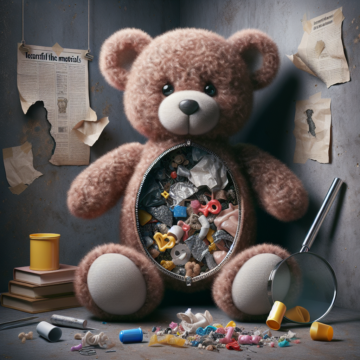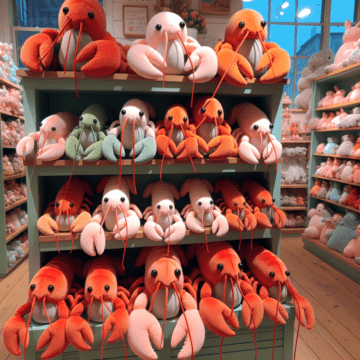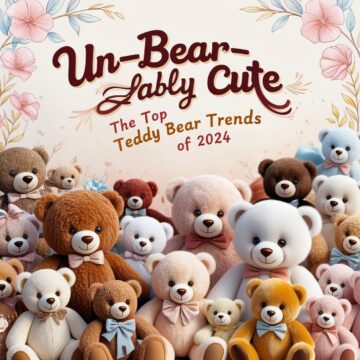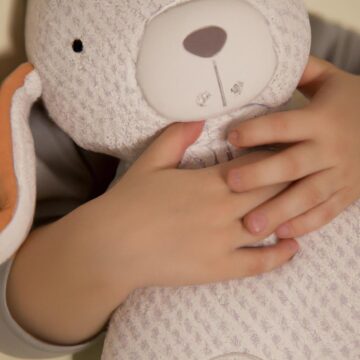
The joy on your child’s face when they receive a new plush toy is something every parent cherishes. However, those seemingly innocent and cuddly companions could potentially pose some hidden dangers that are often overlooked. In this comprehensive guide titled “The Hidden Dangers of Low-Quality Plush Toys: What Every Parent Should Know”, we delve into the lesser-known risks associated with these toys and why it’s crucial to ensure the quality of every fluffy friend your child gets. From hazardous materials to poor construction, we’re going to open your eyes to the potential hazards lurking in your child’s toy box. This is an essential read for every parent, grandparent, or caregiver who values the safety and well-being of their little ones. It’s time to make informed decisions when it comes to choosing the right plush toys for your children, and we’re here to help you do just that.
- 1. Understanding the Risks: The Unseen Hazards of Low-Quality Plush Toys
- 2. Unraveling the Truth: Harmful Materials Used in Inexpensive Stuffed Animals
- 3. Spotting the Danger: How to Identify and Avoid Low-Quality Plush Toys
- 4. Choking Hazards and Ingestion Risks: The Silent Threat of Poorly-Made Soft Toys
- 5. More Than Just Allergies: Health Complications Linked to Low-Quality Plush Toys
Understanding the Risks: The Unseen Hazards of Low-Quality Plush Toys

In the realm of children’s toys, plush toys hold a special place due to their soft and cuddly nature. However, the unseen hazards associated with low-quality plush toys can pose significant risks to the safety and wellbeing of your little ones. It’s essential to be aware that not all plush toys are created equal. Toys of inferior quality can harbor harmful substances, like lead or phthalates, which are unsafe for children and can lead to severe health complications. Additionally, poor craftsmanship can result in small parts becoming detached and posing a choking hazard. Even the fluff inside these toys, if of low quality, can cause allergies or respiratory issues. Parents and caregivers must take the time to ensure their chosen plush toys are of high quality, free from toxic substances, and well-constructed. Investing in safe, well-made plush toys is a crucial step towards safeguarding your children’s health and promoting their safe play.
Unraveling the Truth: Harmful Materials Used in Inexpensive Stuffed Animals
Affordable plush toys may seem like a harmless delight for your child, but the harsh reality is that they can pose significant health hazards, largely due to the harmful materials used in their manufacturing. The lure of inexpensive stuffed animals often blinds parents to the potential risks hidden beneath their soft, cuddly exteriors. One of the primary culprits is lead, a highly dangerous substance, often found in the dyes used for these toys. Prolonged exposure can lead to severe developmental and neurological issues in children. Another danger lurking in these furry friends is phthalates. These chemical compounds, used to make plastic more flexible and durable, have been linked to hormonal imbalances and reproductive issues. In addition, cheap stuffing materials such as synthetic fibers can cause allergic reactions and respiratory problems. As parents, understanding these dangers is crucial to safeguard your child’s health against the harmful substances often found in low-quality plush toys. By opting for high-quality, safety-tested stuffed animals, you can provide your child with a safe and enjoyable play experience.
Spotting the Danger: How to Identify and Avoid Low-Quality Plush Toys
When it comes to children’s toys, not all are created equal, especially when we delve into the world of plush toys. Parents often find it hard to distinguish between high-quality and low-quality plush toys, leading to unintentional exposure of their children to potential hazards. Understanding the risks associated with low-quality plush toys is crucial for ensuring the safety and health of your little ones.
Firstly, one of the telltale signs of a low-quality plush toy is the use of non-durable materials. Plush toys that are easily torn or frayed can pose a serious choking hazard to children, especially those under three years of age. Always inspect the toy for loose parts, such as eyes or buttons, that could potentially be swallowed.
Secondly, low-quality plush toys often lack clear labeling that identifies the materials used, cleaning instructions, or age appropriateness. The absence of this crucial information should be a red flag for any parent as it could indicate the use of harmful substances, including toxic paints or dyes.
Finally, the presence of an unpleasant chemical odor is another indication of a low-quality plush toy. Such odors may be a result of harmful chemicals used in the production process. Always ensure to give a plush toy a good sniff before purchasing it for your child.
In conclusion, it’s essential to be vigilant about the quality of plush toys we introduce into our children’s lives. By knowing what to look out for, parents can ensure their children’s playtime is not only fun, but safe too.
Choking Hazards and Ingestion Risks: The Silent Threat of Poorly-Made Soft Toys
In the enchanting world of children’s playthings, soft toys hold a special place. They are cherished companions that comfort, inspire imagination and foster emotional growth. However, beneath their plush exterior, poorly made soft toys can pose significant dangers, including choking hazards and ingestion risks. These silent threats often go unnoticed until it’s too late. Poor craftsmanship, such as loosely attached eyes, buttons, and other small parts, can easily detach and find their way into your child’s mouth, leading to choking incidents. Furthermore, low-quality plush toys may contain harmful substances like lead or phthalates in their dye or stuffing, posing serious ingestion risks if a child bites or chews on them. It’s crucial for parents to be aware of these potential hazards and to make informed choices when purchasing plush toys. Choosing high-quality, safety-certified plush toys and regularly inspecting them for loose parts or wear and tear can help ensure your child’s playtime remains safe and joyful.
More Than Just Allergies: Health Complications Linked to Low-Quality Plush Toys
When it comes to your child’s health, every detail matters, from the food they eat to the toys they play with. Unfortunately, low-quality plush toys, often loved by children, can potentially lead to more than just allergies. These seemingly harmless playthings can be a hidden source of health complications that every parent should be aware of. The stuffing material, fabric, and dyes used in manufacturing these toys can contain harmful substances, resulting in diverse health issues. Allergic reactions, respiratory problems, skin rashes, and even developmental issues are among the risks associated with these toys. Moreover, poor-quality plush toys can easily tear, posing a choking hazard for young children. Therefore, it’s crucial to ensure the safety of the toys, choose high-quality plush toys, and avoid the dangers lurking in the low-quality alternatives. By doing so, not only will you keep your child safe, but also you’ll contribute to their healthy growth and development.
Conclusion
In conclusion, low-quality plush toys pose numerous hidden dangers that every parent should be aware of. From choking hazards to toxic materials, these seemingly innocent playthings can have potentially harmful effects on your child’s health and safety.
Throughout the course of this article, we have explored several key points that underline the importance of choosing high-quality plush toys for your child. We delved into the possible physical hazards, such as small parts that may break off and cause choking, or poorly constructed toys that can easily fall apart under the duress of enthusiastic play.
We looked at the dangers of toxic materials that could be found in low-quality toys, including lead paint and other harmful substances. These materials can be especially dangerous for young children who often put toys in their mouths, risking ingestion of harmful toxins.
We also discussed the potential allergenic properties of low-quality plush toys. Synthetic materials and harmful chemicals used in low-grade toys can trigger allergies and cause discomfort or illness in children with sensitivities.
Moreover, we highlighted the importance of age-appropriate toys, as a plush toy intended for an older child may not be safe for a toddler. Parents should always check the age recommendations on toys to ensure they are suitable for their child’s age group.
Lastly, we discussed the importance of proper maintenance and regular cleaning of plush toys for child safety. Harmful bacteria and mold can grow on dirty toys, which may lead to health problems.
Choosing the right toy for your child is more than a matter of keeping them entertained; it’s a matter of keeping them safe. When purchasing plush toys, quality should always be a priority over price.
As a parent, it’s essential to be mindful of the hidden dangers that can lurk within the cuddly exterior of low-quality plush toys. So, the next time you find yourself in a toy store or browsing online, remember that not all that is soft and cuddly is necessarily safe.
In a world where countless products are vying for your attention, making informed decisions can feel like a daunting task. However, equipped with the right knowledge, you can ensure that your child’s playtime is not just fun, but safe as well. Because every giggle, every hug, and every moment of joyous play is priceless, and so is your child’s safety.


